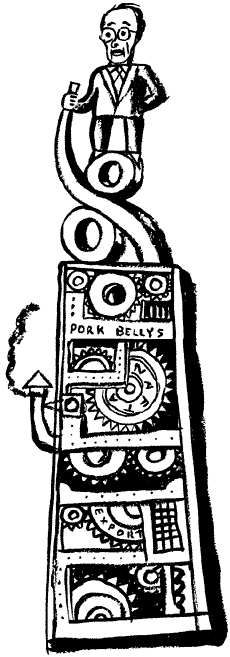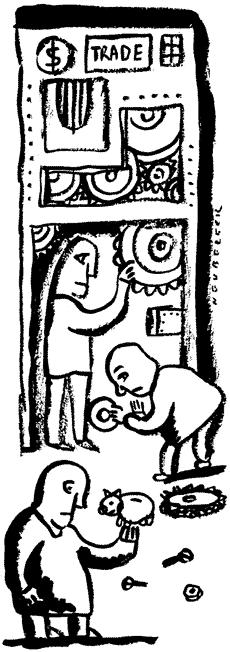
|
Vulgar Keynesians
A penny spent is not a penny earned?
By Paul Krugman
(1,799 words;
posted Thursday, Feb. 6; to be composted Thursday, Feb. 13)
Economics, like all
intellectual enterprises, is subject to the law of diminishing disciples.
A great innovator is entitled to some poetic license. If his ideas are
at first somewhat rough, if he exaggerates the discontinuity between his
vision and what came before, no matter: Polish and perspective can come
in due course. But inevitably there are those who follow the letter of
the innovator's ideas but misunderstand their spirit, who are more dogmatic
in their radicalism than the orthodox were in their orthodoxy. And as ideas
spread, they become increasingly simplistic--until what eventually becomes
part of the public consciousness, part of what "everyone knows,"
is no more than a crude caricature of the original.
Such has been
the fate of Keynesian economics. John Maynard Keynes himself was a magnificently
subtle and innovative thinker. Yet one of his unfortunate if unintentional
legacies was a style of thought--call it vulgar Keynesianism--that confuses
and befogs economic debate to this day.
Before the 1936 publication of Keynes'
The General Theory of Employment, Interest, and Money, economists
had developed a rich and insightful theory of microeconomics, of
the behavior of individual markets and the allocation of resources among
them. But macroeconomics--the study of economy-wide events like
inflation and deflation, booms and slumps--was in a state of arrested development
that left it utterly incapable of making sense of the Great Depression.
|
|
|

|
So-called "classical" macroeconomics asserted that the economy
had a long-run tendency to return to full employment, and focused only
on that long run. Its two main tenets were the quantity theory of money--the
assertion that the overall level of prices was proportional to the quantity
of money in circulation--and the "loanable funds" theory of interest,
which asserted that interest rates would rise or fall to equate total savings
with total investment.
Keynes was willing to concede that
in some sufficiently long run, these theories might indeed be valid; but,
as he memorably pointed out, "In the long run we are all dead."
In the short run, he asserted, interest rates were determined not by the
balance between savings and investment at full employment but by "liquidity
preference"--the public's desire to hold cash unless offered a sufficient
incentive to invest in less safe and convenient assets. Savings and investment
were still necessarily equal; but if desired savings at full employment
turned out to exceed desired investment, what would fall would be not interest
rates but the level of employment and output. In particular, if investment
demand should fall for whatever reason--such as, say, a stock-market crash--the
result would be an economy-wide slump.
It was a brilliant re-imagining of
the way the economy worked, one that received quick acceptance from the
brightest young economists of the time. True, some realized very early
that Keynes' picture was oversimplified; in particular, that the level
of employment and output would normally feed back to interest rates, and
that this might make a lot of difference. Still, for a number of years
after the publication of The General Theory, many economic theorists
were fascinated by the implications of that picture, which seemed to take
us into a looking-glass world in which virtue was punished and self-indulgence
rewarded.
Consider, for example, the "paradox
of thrift." Suppose that for some reason the savings rate--the fraction
of income not spent--goes up. According to the early Keynesian models,
this will actually lead to a decline in total savings and investment.
Why? Because higher desired savings will lead to an economic slump, which
will reduce income and also reduce investment demand; since in the end
savings and investment are always equal, the total volume of savings must
actually fall!
Or consider the "widow's cruse"
theory of wages and employment (named after an old folk tale). You might
think that raising wages would reduce the demand for labor; but some early
Keynesians argued that redistributing income from profits to wages would
raise consumption demand, because workers save less than capitalists (actually
they don't, but that's another story), and therefore increase output
and employment.
 |
|
|
|
 uch
paradoxes are still fun to contemplate; they still appear in some freshman
textbooks. Nonetheless, few economists take them seriously these days.
There are a number of reasons, but the most important can be stated in
two words: Alan Greenspan. uch
paradoxes are still fun to contemplate; they still appear in some freshman
textbooks. Nonetheless, few economists take them seriously these days.
There are a number of reasons, but the most important can be stated in
two words: Alan Greenspan.
After all, the simple Keynesian story
is one in which interest rates are independent of the level of employment
and output. But in reality the Federal Reserve Board actively manages interest
rates, pushing them down when it thinks employment is too low and raising
them when it thinks the economy is overheating. You may quarrel with the
Fed chairman's judgment--you may think that he should keep the economy
on a looser rein--but you can hardly dispute his power. Indeed, if you
want a simple model for predicting the unemployment rate in the United
States over the next few years, here it is: It will be what Greenspan wants
it to be, plus or minus a random error reflecting the fact that he is not
quite God.
 |
 |
|
|
 ut
putting Greenspan (or his successor) into the picture restores much of
the classical vision of the macroeconomy. Instead of an invisible hand
pushing the economy toward full employment in some unspecified long run,
we have the visible hand of the Fed pushing us toward its estimate of the
noninflationary unemployment rate over the course of two or three years.
To accomplish this, the board must raise or lower interest rates to bring
savings and investment at that target unemployment rate in line with each
other. And so all the paradoxes of thrift, widow's cruses, and so on become
irrelevant. In particular, an increase in the savings rate will translate
into higher investment after all, because the Fed will make sure that it
does. ut
putting Greenspan (or his successor) into the picture restores much of
the classical vision of the macroeconomy. Instead of an invisible hand
pushing the economy toward full employment in some unspecified long run,
we have the visible hand of the Fed pushing us toward its estimate of the
noninflationary unemployment rate over the course of two or three years.
To accomplish this, the board must raise or lower interest rates to bring
savings and investment at that target unemployment rate in line with each
other. And so all the paradoxes of thrift, widow's cruses, and so on become
irrelevant. In particular, an increase in the savings rate will translate
into higher investment after all, because the Fed will make sure that it
does.
To me, at least, the idea that changes
in demand will normally be offset by Fed policy--so that they will, on
average, have no effect on employment--seems both simple and entirely reasonable.
Yet it is clear that very few people outside the world of academic economics
think about things that way. For example, the debate over the North American
Free Trade Agreement was conducted almost entirely in terms of supposed
job creation or destruction. The obvious (to me) point that the average
unemployment rate over the next 10 years will be what the Fed wants it
to be, regardless of the U.S.-Mexico trade balance, never made it into
the public consciousness. (In fact, when I made that argument at one panel
discussion in 1993, a fellow panelist--a NAFTA advocate, as it happens--exploded
in rage: "It's remarks like that that make people hate economists!")
 |
|
|
|
 hat
has made it into the public consciousness--including, alas, that
of many policy intellectuals who imagine themselves well informed--is a
sort of caricature Keynesianism, the hallmark of which is an uncritical
acceptance of the idea that reduced consumer spending is always a bad thing.
In the United States, where inflation and the budget deficit have receded
for the time being, vulgar Keynesianism has recently staged an impressive
comeback. The paradox of thrift and the widow's cruse are both major themes
in William Greider's latest book, which I
discussed last month. (Although it is doubtful whether Greider
is aware of the source of his ideas--as Keynes wrote, "Practical men,
who believe themselves quite exempt from any intellectual influence, are
usually the slaves of some defunct economist.") It is perhaps not
surprising that the same ideas are echoed by John B. Judis in the New
Republic; but when you see the idea that higher savings will
actually reduce growth treated seriously in Business
Week ("Looking for Growth in All the Wrong Places,"
Feb. 3), you realize that there is a real cultural phenomenon developing. hat
has made it into the public consciousness--including, alas, that
of many policy intellectuals who imagine themselves well informed--is a
sort of caricature Keynesianism, the hallmark of which is an uncritical
acceptance of the idea that reduced consumer spending is always a bad thing.
In the United States, where inflation and the budget deficit have receded
for the time being, vulgar Keynesianism has recently staged an impressive
comeback. The paradox of thrift and the widow's cruse are both major themes
in William Greider's latest book, which I
discussed last month. (Although it is doubtful whether Greider
is aware of the source of his ideas--as Keynes wrote, "Practical men,
who believe themselves quite exempt from any intellectual influence, are
usually the slaves of some defunct economist.") It is perhaps not
surprising that the same ideas are echoed by John B. Judis in the New
Republic; but when you see the idea that higher savings will
actually reduce growth treated seriously in Business
Week ("Looking for Growth in All the Wrong Places,"
Feb. 3), you realize that there is a real cultural phenomenon developing.
To justify the claim that savings
are actually bad for growth (as opposed to the quite different, more reasonable
position that they are not as crucial as some would claim), you must convincingly
argue that the Fed is impotent--that it cannot, by lowering interest rates,
ensure that an increase in desired savings gets translated into higher
investment.
 |
|
|
|
 t
is not enough to argue that interest rates are only one of several
influences on investment. That is like saying that my pressure on the gas
pedal is only one of many influences on the speed of my car. So what? I
am able to adjust that pressure, and so my car's speed is normally determined
by how fast I think I can safely drive. Similarly, Greenspan is able to
change interest rates freely (the Fed can double the money supply in a
day, if it wants to), and so the level of employment is normally determined
by how high he thinks it can safely go--end of story. t
is not enough to argue that interest rates are only one of several
influences on investment. That is like saying that my pressure on the gas
pedal is only one of many influences on the speed of my car. So what? I
am able to adjust that pressure, and so my car's speed is normally determined
by how fast I think I can safely drive. Similarly, Greenspan is able to
change interest rates freely (the Fed can double the money supply in a
day, if it wants to), and so the level of employment is normally determined
by how high he thinks it can safely go--end of story.
No, to make sense of the claim that
savings are bad you must argue either that interest rates have no
effect on spending (try telling that to the National Association of Homebuilders)
or that potential savings are so high compared with investment opportunities
that the Fed cannot bring the two in line even at a near-zero interest
rate. The latter was a reasonable position during the 1930s, when the rate
on Treasury bills was less than one-tenth of 1 percent; it is an arguable
claim right now for Japan, where interest rates are about 1 percent. (Actually,
I think that the Bank of Japan could still pull that economy out of its
funk, and that its passivity is a case of gross malfeasance. That, however,
is a subject for another column.) But the bank that holds a mortgage on
my house sends me a little notice each month assuring me that the interest
rate in America is still quite positive, thank you.
Anyway, this is a moot point, because
the people who insist that savings are bad do not think that the Fed is
impotent. On the contrary, they are generally the same people who insist
that the disappointing performance of the U.S. economy over the past generation
is all the Fed's fault, and that we could grow our way out of our troubles
if only Greenspan would let us.
 |
|
|
|
 et's
quote the Feb. 3 Business Week commentary: et's
quote the Feb. 3 Business Week commentary:
Some contrarian economists argue that forcing up savings
is likely to slow the economy, depressing investment rather than sparking
it. "You need to stimulate the investment decision," says University
of Texas economist James K. Galbraith, a Keynesian. He would rather stimulate
growth by cutting interest rates.
So, increasing savings
will slow the economy--presumably because the Fed cannot induce an increase
in investment by cutting interest rates. Instead, the Fed should stimulate
growth by cutting interest rates, which will work because lower interest
rates will induce an increase in investment.
Am I missing something?

|
|
|
|
To read the reply
of "Vulgar Keynesian" James K. Galbraith, in which he explains
green cheese and Keynes, click here.
 Links Links

Here is a biography of the revered Keynes, complete with
a photo.
The Great
Depression home page analyzes the causes of the Depression from
a Keynesian perspective. Check out the Web page of the "visible hand,"
the Federal
Reserve. If you have any doubt that Alan Greenspan is near-omnipotent,
see the text
of his subtle speech that sent stocks crashing and an article
explaining the mayhem. Decide whether you believe NAFTA will affect the
employment rate in the United States: The NAFTA
net page has the text of the agreement as well as several sources
of information on it.
Paul Krugman is a professor of economics at MIT whose
books include The Age of Diminished Expectations and Peddling
Prosperity.
Illustrations by Robert Neubecker

|
|
|